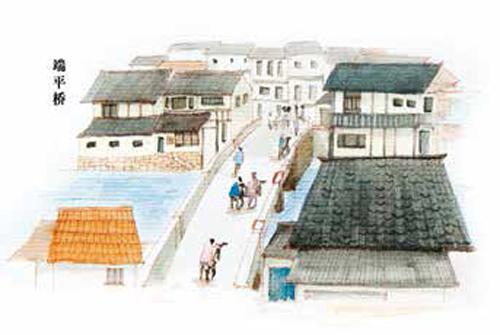Jiaxing Glorified in History and Culture
2019-02-25YangZiqiang
Yang Ziqiang
Jiaxing in northern Zhejiang abounds in rivers, ponds, and lakes. The local dialect presents a group of words to classify them and indicate numerous geographic features. The most famous place names are Majiabang and South Lake. Majiabang, which literarily means a small village on a creek named after the family surnamed Ma, is where an ancient culture was unearthed in the 1950s. The Majiabang Culture goes back to about 5,000 years ago. South Lake was where the Communist Party of China held the last session of its first national congress in the summer of 1921, ushering in a completely new epoch for modern China.
The history of Jiaxing is presumably associated with one and half emperors and half a crown prince. It is said that the First Emperor of the Qin sent more than 100,000 prisoners to the present-day Jiaxing after learning from a wizard that the place was to produce an emperor a few hundred years later. The prisoners worked to destroy the so-called underground dragon vein. During the Three Kingdoms (220-280AD), Emperor Sun Quan was based primarily in Zhejiang and Jiangsu though his kingdom extended much to the south. His son Sun He was the crown prince. As the emperor ruled one third of the country and as the crown prince didnt last long after his father passed away, they are said to have been half an emperor and half a crown prince associated with the history of Jiaxing.
Nicolae Milescu, named in 1675 ambassador of the Russian Empire to Beijing, the capital of Qing China, returning in 1678, wrote a travelogue which described his travels in China. The travelogue was translated into Chinese a long time ago. One of the chapters describes Jiaxing. It would be interesting to know that some people say the cityscape of Jiaxing hasnt changed much from the city the Russian envoy saw and described. After all, prosperity has remained largely unchanged.

An artists impression of the boat and the pavilion on the South Lake, Jiaxing
Jiaxing boasts some local delicacies of which local people are very proud. Jiaxing Zongzi, a traditional Chinese rice dish made of glutinous rice stuffed with different fillings and wrapped in bamboo leaves, in the eyes of the local people, represents a regional cohesion, which sticks together and never leaks figuratively. Water Chestnut of South Lake, a special species of water caltrop, has seeds without the horn-like parts. It is considered proudly by local people as an image of themselves: they are peace-loving people and they dislike discord.
Jiaxing stands out in the modernization of Chinese language. Chinese mathematician Li Shanlan (1811-1882), a native of Jiaxing, translated Botany into Chinese and “cell” in English was rendered into Chinese as 細胞, which is still used in Chinese today. Scholars claim that the term reflects the flavor of the dialect of Jiaxing. In collaboration with westerners, Li translated many Western mathematical works into Chinese. A great number of mathematical terms used in Chinese today were first coined by him.
The first Chinese pinyin system was developed by Zhu Xizu (1879-1944), a native of Jiaxing, in 1913, two years after the mighty Qing fell apart. It was jointly signed by Lu Xun and many other personages. This Pinyin system made new primary schools in the western style possible in the Republic of China founded in 1911. In 1919, Zhu Xizu and five other scholars proposed a modified system of Chinese punctuation marks to the Ministry of Education. The system was officially issued in 1920, paving way for the spread of the written vernacular Chinese.
Zhu Xizu served as the dean of the history department of Peking University in 1918. It was the first time that literature and history became two different study subjects in Chinas history of 5,000 years.
It could probably be justifiable to say that Jiaxing is associated with the popularity of the Tang poems, the very climax of the traditional poetry in the Chinese history. Today in China children read a primer called , which has been a popular poetry reader for the last three hundred years. It was compiled in 1765 on the basis of the commissioned in 1705 at the direction and published under the name of the Qing dynasty Kangxi Emperor. The was based upon another colossal collection of the Tang poems put together by Hu Zhenheng (1569-1645), a native of Jiaxing. It was the most complete databank of the Tang poems in the Ming Dynasty (1368-1644).

An artists imagination of Duanping Bridge in old-time Jiaxing
And Jiaxing boasts Wang Gai, a name little known to most people. But he was one of the authors of a printed manual of Chinese painting compiled during the early period of the Qing Dynasty (1644-1911). Many renowned later Chinese painters, like Qi Baishi, began their drawing lessons with the manual. Since its publication in 1701, millions of Chinese art students have used it as a primary manual.
German philosopherGeorg Wilhelm Friedrich Hegel (1770- 1831) in mentioned , a Chinese novel. It was an early-Qing Chinese romance by Zhang Yun, a native of Jiaxing. Back then, it enjoyed tremendous popularity in Europe, with the French, English, and German, Latin and Russian translations published in the 1820s. Lu Xun mentioned, in , that the novel enjoyed popularity in foreign countries whereas it was little known in China.
